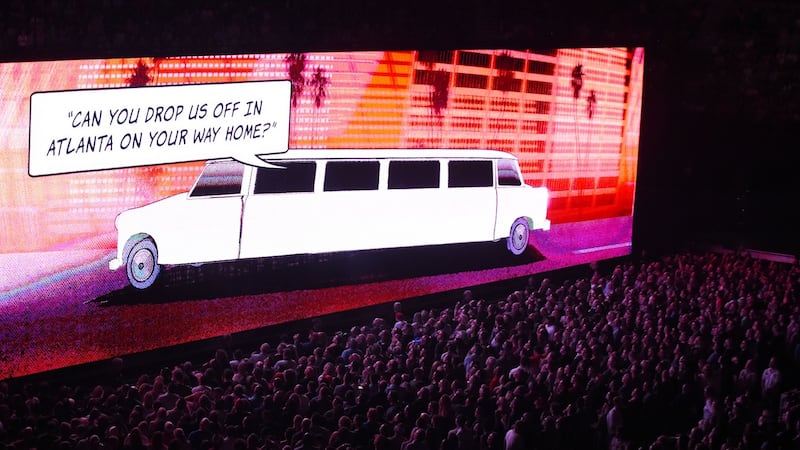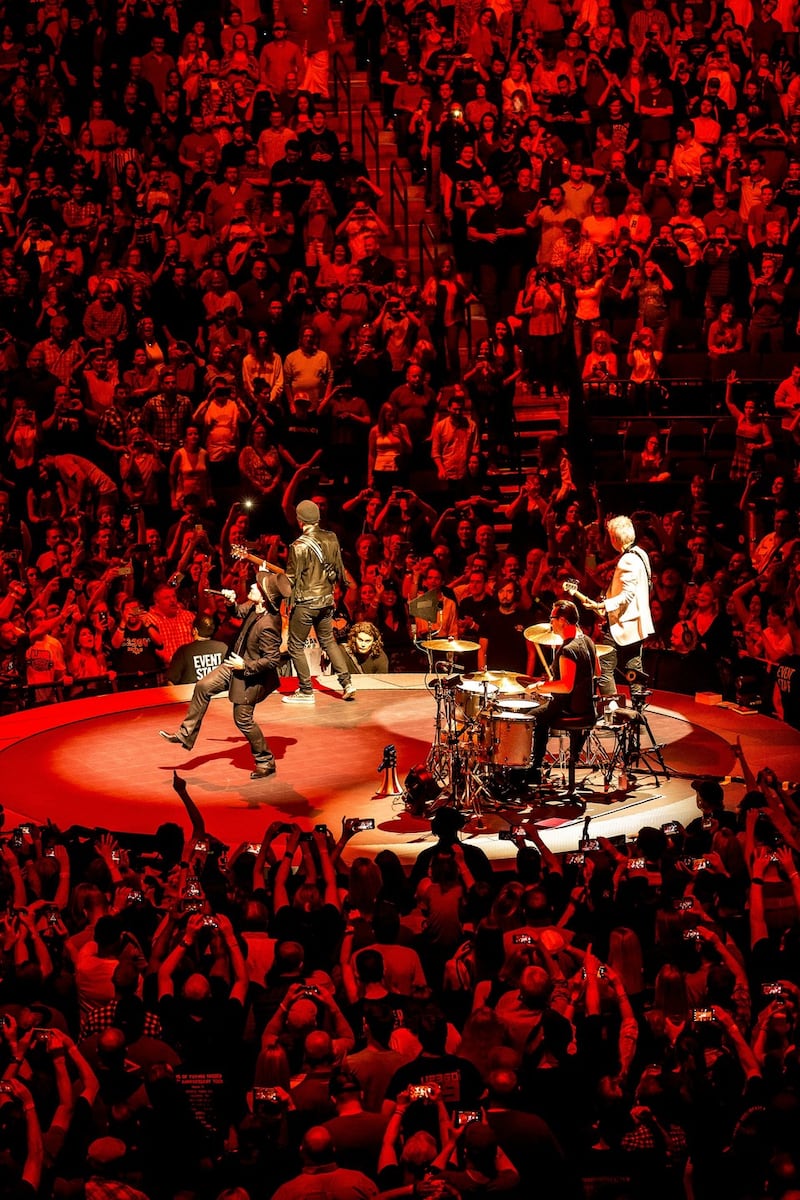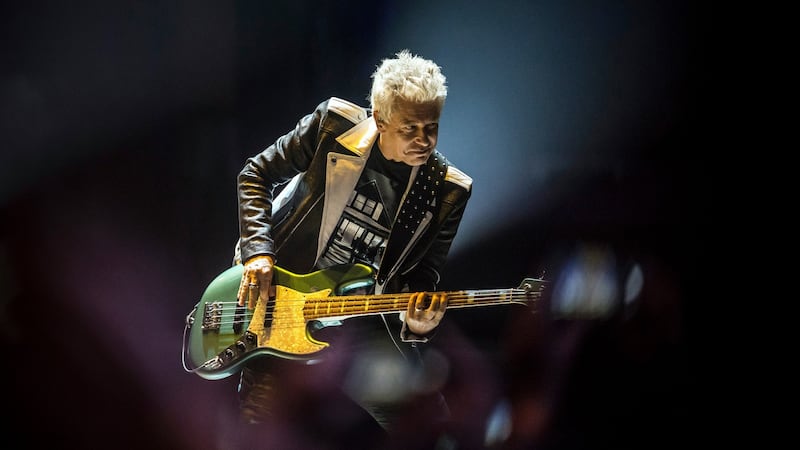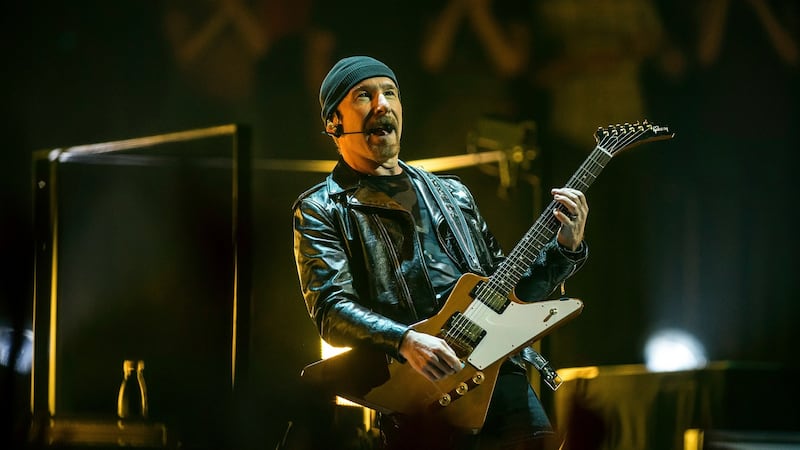By any yardstick a 61-date world tour is going to be gruelling, not least on the back of a 51-show tour only a year earlier. But the home stretch is within sight for U2 as they arrive in Ireland for all but one of their final Experience + Innocence shows – and probably not before time.
Their very last show of the tour, in Berlin next month, is to make up for having had to cut short a September date in the city, when Bono lost his voice after five songs. That misfortune prompted fans on U2's Zootopia message board to wonder whether the frontman was feeling the gravity of his 58 years.
There were few such qualms on the opening night of the tour, in the United States in May. The scene, in fact, was less a harbinger of the doom to come than a sign that Irish audiences have much to look forward to at U2's Belfast and Dublin gigs over the next fortnight.
In U2's 42-year history there have been ups and downs, but in recent years things have got even uppier and downier. Triumph has come tumbling on the heels of catastrophe
Ahead of the tour's opening show, in the Oklahoma city of Tulsa, the lines snaked around the block while a lone evangelist with a megaphone denounced rock'n'roll. Some of the band's more fervent fans, who had been queuing outside the arena in capricious weather for five days, were basking in the afterglow of a nice surprise: Bono and the Edge had brought them pizza and ice pops the day before.
Other fans had gathered closer to the venue's loading bay, hopeful of even a momentary encounter with the band. Many were from Mexico, Spain and Denmark. Some were seeing U2 for the first time; another had seen U2 play 130 times.
David, an Oklahoman, couldn't quite believe that U2 were opening their world tour in his state. He had heard there would be a nod in that night's show to anti-Trump sentiment. (When U2 played the prequel Innocence + Experience tour, in 2015, Barack Obama was still the US president.)
“That’s going to be welcomed here,” David said. “While it’s a conservative environment, there are a lot of fans here, and the general population will be more compassionate towards other people, and don’t feel like Trump represents them.”
In the end the onstage references to the 45th president of the United States were oblique. “It’s getting dangerous out there in America, and I’m not just talking about the weather,” Bono shouted to the 19,000-strong audience.
Yet with imagery of the Ku Klux Klan, Martin Luther King and swastikas at a Charlottesville white-nationalist rally blazing from giant screens throughout their three-hour set, U2 had evidently not entered the Bible Belt with a view to treading softly.
Some of the audience members cheered at the imagery (whether or not in support of U2’s stance it was hard to tell), while for others the unease was palpable. “I think it’s going to ruffle some feathers for sure,” the Edge said as he sat down for a round-table interview in the backroom of a Tulsa restaurant on the eve of the tour.
“We hadn’t played Tulsa in living memory, so we said, ‘Yeah, great, let’s do it. Then it dawned on us that it is quite a conservative part of America. Then we got excited about that aspect of it, and the show being seen for the first time in a place that really is not a typical rock’n’roll centre.”
What to expect from U2’s Experience + Innocence shows
- Most of the band's shows in this tour clock in at three hours long, often starting at 8.15pm with no support act (although, somewhat intriguingly, the band warm up to I Break Horses' hit Winter Beats right before taking the stage).
- Most notably, the Experience + Innocence stage features a "barricage", a 20-tonne, 30m elevated cage that allows the band to walk across the arena above the crowd while images are projected on to its sides.
- The band has also released U2 Experience, a free augmented-reality app for concertgoers to download before the show. Available for iOS and Android, it asks for access to your smartphone's camera and then invites you to point your phone at the stage to see the app's 3D visuals.
- According to U2.com, the augmented-reality scene-setter is triggered by the LED wall running the length of the arena floor and heralds the band's arrival on stage. "It's a live show experience you can share with all your friends, as well as thousands of other fans at the show."
Is it safe to say that U2 in the United States are a different beast from U2 in Ireland? At home U2 are like Leaving Cert Irish, or fluoride in the water: a bone of contention for some, reason for enshrinement by others, but mostly always there. In a 42-year history there have been ups and downs, but in recent years things have got, well, even uppier and downier. Triumph has come tumbling on the heels of catastrophe. In 2014 the band waded into an almighty kerfuffle when their album Songs of Innocence was automatically "gifted" to 500 million iTunes accounts. That same year a "cycling spill" (or "brush with mortality", according to one interview) put Bono out of commission; in 2015 there was a health scare. Add a slew of mixed album reviews, scrutiny about financial affairs (the Guardian described Bono as "the Samaritan who avoids the taxman") and the departure of their "fifth" member, their manager Paul McGuinness, a year previously, and it was a trying time by anyone's measure.
The Joshua Tree anniversary tour, in 2017, saw a huge upswing in U2's fortunes, when even the haughtiest music snob was forced to grovel with the #ticketfairy hashtag: the tour took in $317 million, making it the highest-grossing of the year. Looking backwards, it seems, has stood them in good stead.

Little wonder, then, that U2 have been in an especially reflective mood of late. Much like its companion album, Song of Innocence, their 14th album, Songs of Experience, sees the band nod to their origin years. Evoking shades of Achtung Baby (on Lights of Home) and The Joshua Tree (on The Little Things That Give You Away), the album hints at a band succumbing to nostalgia.
The messianic telegraphing of pressing social issues, most notably the Syrian refugee crisis, is still present, but this is also one of the band's most personal albums. As if to cement this idea, the album cover features a stark black-and-white image of Elijah Hewson, Bono's son, and Sian Evans, Edge's daughter, the latter wearing a military helmet not unlike the one a young Peter Rowan wore on the cover of The Best of 1980-1990.
Both youngsters also appear in the visuals on the Experience + Innocence tour, alongside a wave of memories from the band's youth: the semi-detached house on Cedarwood Road that Bono grew up in; green Telefón boxes; bovver boots; posters of The Clash and Kraftwerk. Elsewhere in the show, footage of Bono's parents' wedding day, as well as his late mother running on Loughshinny beach, plays against the song Iris.
In Tulsa this song, sandwiched between The Ocean and Cedarwood Road, saw U2 and Bono in particular at their most touchingly confessional, although for a crowd chomping for barnstorming anthems the newish trilogy resulted in a slight lull.

That U2 have been retracing their steps so keenly is enough to make anyone wonder where exactly it all went right, and maybe wrong, for them. Thin Lizzy, Rory Gallagher and Van Morrison all came before them, but U2 appeared to be the first Irish act to make an unapologetic grab for global superstardom. And when they did, their rise came at a particularly enlivening cultural moment. Thanks to the band's successes in the late 1980s and early 1990s, it wasn't unusual to see A&R giants such as Muff Winwood or Ahmet Ertegun knocking about in such tiny Dublin venues as McGonagles or the Baggot Inn as part of the chase to find the next big thing.
Revisiting the Joshua Tree era as part of last year's 51-date tour, Adam Clayton said in Tulsa, was really weird. "It like it was 1987" again, the bassist recalled. "At the time – I think I said this in interviews before – we were so kind of uptight and obsessed with having this hit record that we didn't really notice what was happening with the record and how deep those songs went with people. So then last year, when we went back to them, just the power and the simplicity of those songs. Noel Gallagher was saying, 'That was when you could write really simple songs and play them simply, and they had the sound.' "
Yet in many ways the U2 that made the Irish music scene pulsate in the 1980s are several incarnations away from the group that have put together this year's wallet-busting spectacle. With 90 touring crew and 150 local hands, erecting the Experience + Innocence tour stage is a 10-hour operation. The set-up is again the work of two long-time collaborators, the stage designer Willie Williams and the set designer Ric Lipson (who has also worked with Beyoncé and the Rolling Stones). The set-up will be largely familiar to anyone who saw the Innocence + Experience tour, although technological advances mean the screen in the centre of the arena now has a far higher resolution.


During the midafternoon soundcheck at the BOK Center in Tulsa, Bono and the Edge were trying to fine-tune a visual effect that sees the guitarist stand in the palm of Bono's hand.
“It is sort of like doing a big Marvel movie. Except you are taking it to a different city every few days, and it is a bit mad. And, worse than that, for me it is like a Marvel film where you have to method act,” Bono said. “It was going really shite in the dress rehearsal, but we think we’ve put something in place to make it a little less indulgent.
Referring to the reflective element of the tour, he added: “It is a very personal story, and even though it is my story – we use me, the singer, to tell the story – it could be Larry, Edge or Adam’s story.”
Cedarwood, the road that inspired the song, “is this beautiful street from the past, but of course it is what is in your head that counts. So I am walking down the road thinking it is a war zone – it was a war zone in my teens. It probably wasn’t, but it was in my head. It is a personal story, but trying to take the solipsistic aspect out of it is impossible.”
Sid Vicious punched a hole in the wall. They put a frame around it. We played there, but we weren't old enough to drink there, as we were underage, which is interesting
Bono referred to Cain's Ballroom, a nearby venue that the band played in 35 years ago (and where he and Dave Fanning repaired the day before the show, to watch Liverpool play Bayern Munich).
"Sid Vicious punched a hole in the wall, and they didn't fix it. Instead they put a frame around it," he said, smiling. "We played there, but we weren't old enough to drink there, because we were underage, which is interesting."
Even after all these years, the Edge said, going out on stage is still a big thrill and adrenaline rush. “It will never be any other way for us. It is something we just love to do,” he said.
Might U2 retread yet more hallowed ground with another seminal-album tour? "I don't know. I don't want to say 'never say never'. The thing with The Joshua Tree that kind of made sense was, when we toured it the first time, there was no real stadium production, and when we did Zoo TV and Achtung Baby there was stadium production. It would be hard to go out and reinvent that, but you never know."
The Experience + Innocence tour is at the SSE Arena in Belfast on Saturday, October 27th, and Sunday, October 28th, and at 3Arena in Dublin on November 5th, 6th, 9th and 10th









